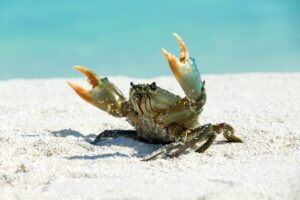It was four in the morning when the man running down the dock started shouting, “Jubilee! Jubilee!”
It was a sweltering August night along the shoreline of Mobile Bay, Alabama, so we had our portholes open and could hear him perfectly.
“What’s that?” Patrick rolled over and crushed a pillow to his head, but I had heard rumors of such a rare phenomenon and wanted to check it out.
I threw on my clothes and hurried down the dock after the man toward the beach. Lights danced along the shoreline, illuminating the figures that had responded to the man’s call.
One man, dressed in a white tank top and camouflage shorts, with the word “BAMA” stretched across the back of his ballcap, held a bucket in one hand and a flashlight on a long stick in the other. He bent down and scooped the bucket through the shallow water, using the light pole as an underwater lamp.
“What’s he doing?” I asked Tom, whom I’d met the day before, as he stood in the still-warm sand watching the show.
“It’s a jubilee. He’s catching shrimp.” Tom nodded toward the water. Standing ten feet from the shrimper, a man in the ubiquitous crimson and white colors of the region was bent at the waist picking blue crab from the shallows and tossing them into a steel wash basin. “There’s a load of crabs to be had, too.”
We wandered closer to the water. The shallows boiled with sea life flopping around, seemingly trying to beach themselves. In a quick scan of the area I counted a dozen flounder.
“Happens each year here on the eastern shore,” Tom said, passing me his lantern and wading into the warm water. “Just before sunrise, once or twice a summer, the fish are driven to shore by a pocket of unoxygenated water. A dead zone, if you will.”
“Do they die?” I asked, unsure if this was the same thing as a red tide.
Tom shook his head. “Only the ones that are caught.”
He held out a four-foot stick with tines like a pitchfork on its end. “Shine the light over here, would you?” He pointed to the left where three flat, bottom-hugging flounder slithered on top of each other.
“They become real slow and sloppy because of the lack of oxygen and are easy to catch.” He thrust the gig into one of the flounder and stabbed him right behind the eyes. “There’s been jubilees where guys claim to have caught a hundred flounder in just an hour.” He strung the flounder on a long length of wire and looped it through his belt, the fish hanging from his side like a set of keys. He speared and strung four more fish as he spoke. “Thing is, it only lasts an hour or so. As soon as the wind blows or the tide changes, mixing oxygenated water back in, the fish can breathe again and scatter back to the depths.”
I looked down at the warm water lapping at my bare feet. The wild scramble of flounder, shrimp, crabs and even an eel or two was the densest concentration of sea life I’d ever seen. They were slow and staggering, almost drunk-like, through the shallows. They put up little fight at being caught.
A bell rang farther down the beach. Slowly, as the call of “Jubilee!” went out, the beach filled with people. Some arrived with casting nets, some with flounder gigs like Tom’s, some with buckets. “I seen one woman out here with a laundry basket one year,” Tom told me. His loop was now stretched tight, and the feathery tails of the flounder trailed though the water.
He unbuckled the wire from his belt and handed it to me. “Here, this is for you.”
“Are you sure?” I asked, reminded of how much I loved the Southern spirit of generosity and hospitality.
“Sure thing, sweetie.” Tom winked at me in the predawn light. “I’ll get more than me and the missus can eat before the tide changes.”
And sure enough, he did. Within twenty minutes, Tom’s second line was full.
A slight breeze blew wisps of my hair across my face.
Tom looked up and studied the sky. “That’ll be the end of it.”
I looked down at the water at his feet. What once was alive with squirming, squiggling fish was now noticeably stiller and less crowded.
Tom swung the forked end of his stick into the air and held it like Poseidon’s trident. He patted the again-heavy string of flounder on his hip. “Good thing we got here early.”
We turned and walked back up the dock as the last of the flounder retreated to deeper water.
I held up the string he had given me. “I’m glad someone called out. Thank you.”
“My pleasure.” The lines beside his eyes crinkled deeper. “Won’t be another until next year now. Just make sure you listen for the cry of ‘Jubilee!’”
Pecan-crusted Flounder with Cheesy Grits and Satsuma Salsa
This dish is great with steamed green beans, asparagus, sautéed spinach, or kale.
For the satsuma salsa:
- 4 satsuma oranges, peeled and juiced
- ½ shallot, minced
- 1 tablespoon thyme
- ¼ teaspoon sea salt
- ¼ cup olive oil
- 2-4 drops hot sauce, depending on tolerance
For the flounder:
- 6 fillets flounder, 6 ounces each
- Salt and pepper
- 1 cup buttermilk
- 3 cups pecans, finely ground
- 3 tablespoons olive oil
For the cheesy grits:
- 2 tablespoons olive oil
- 6 cloves garlic, minced
- 2 shallots, diced
- 4 cups chicken stock
- 2 cups grits
- 2 tablespoons heavy cream
- 2 cups white cheddar cheese
- Salt and pepper
1. Place all ingredients for the salsa in a medium-sized bowl and stir. Taste for seasoning and set aside.
2. Season the buttermilk with salt and pepper and set in a bowl. Place the ground pecans in a bowl beside the buttermilk. Dip the top side of each flounder fillet in the buttermilk, then press that side into the pecans to coat the top of the fish. Set fillets aside.
3. Heat a medium saucepan over medium heat. Add the olive oil for the grits, the garlic and shallots, and cook, stirring frequently, until translucent.
4. Add the chicken stock and bring to a boil. Add grits and stir constantly until chicken stock is evaporated. Add cream and cheese and season with salt and pepper. Set aside.
5. Preheat oven to 300 degrees.
6. Heat large pan over medium heat. Add the flounder fillets, pecan-crusted sides down. Season the exposed sides of the fish with salt and pepper and cook for about two minutes until nuts start to roast.
7. Place the pan in the oven and cook for 10 minutes until the fish is opaque.
8. Place a dollop of the cheesy grits in the center of each plate and lay the flounder on top, pecan-side up. Spoon salsa and its juices over the fish.





